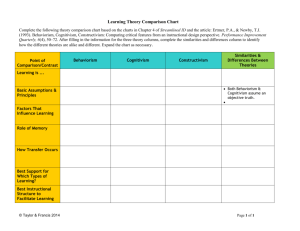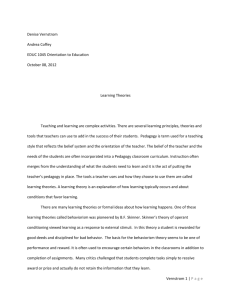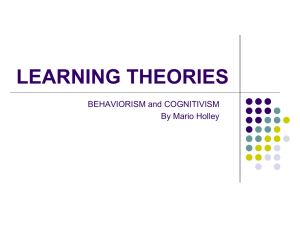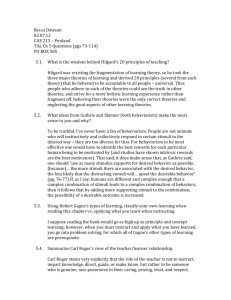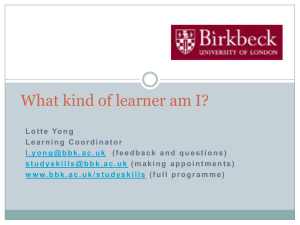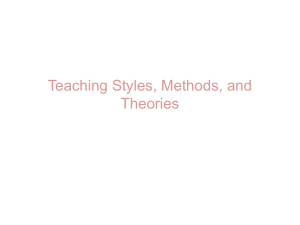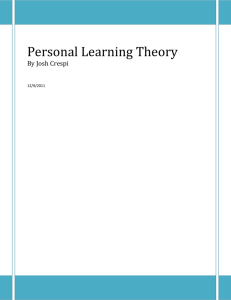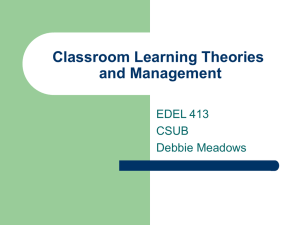T L P and P Unit -3 - New Life College of Nursing
advertisement
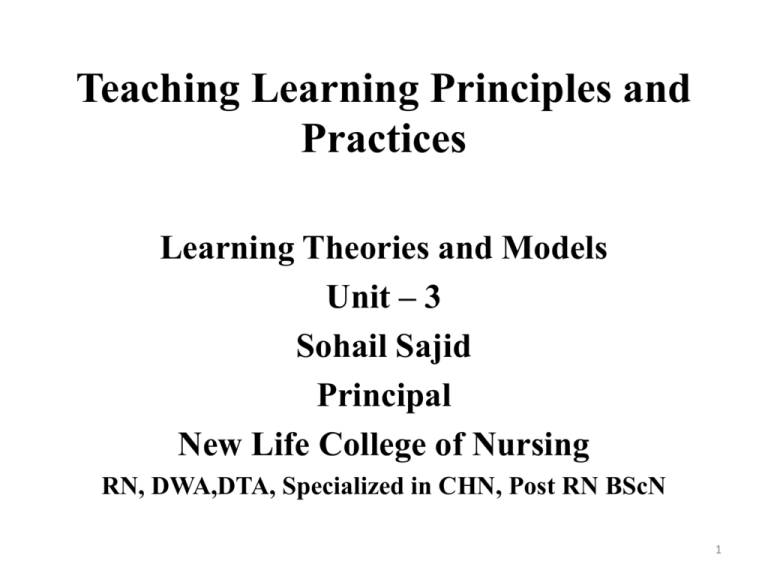
Teaching Learning Principles and Practices Learning Theories and Models Unit – 3 Sohail Sajid Principal New Life College of Nursing RN, DWA,DTA, Specialized in CHN, Post RN BScN 1 Objectives • • • • • Define learning Discuss learning process Discuss learning theories Discuss Kolb’S and Tyler learning model Analyze learning theories and models in daily learning activities • Compare teaching learning strategies which enhance learning 2 Learning • When an individual gains knowledge, skill and understanding the subject learning changes attitude and behavior it is known as learning. • Learning is considered as a change in a person has caused by experience. (Basanvanthappa) 3 Learning Process • To learn is to acquire knowledge or skill. Learning also may involve a change in attitude or behavior. Children learn to identify objects at an early age; teenagers may learn to improve study habits; and adults can learn to solve complex problems. • The challenge for the aviation instructor is to understand how people learn, and more importantly, to be able to apply that knowledge to the learning environment. 4 Teaching Learning Process • Teaching learning process is a transaction or a complex cooperative and personal relation between faculty and student. (Basanvanthappa) 5 Learning Theories • Learning theory may be described as a body of principles advocated by psychologists and educators to explain how people acquire skills, knowledge, and attitudes. Various branches of learning theory are used in formal training programs to improve and accelerate the learning process. Key concepts such as desired learning outcomes, objectives of the training, and depth of training also apply. 6 Learning Theories • When properly integrated, learning principles, derived from theories, can be useful to aviation instructors and developers of instructional programs. • Learning theories are conceptual frameworks describing how information is absorbed, processed, and retained during learning. Cognitive, emotional, and environmental influence 7 Learning Theories • Behaviorism • Cognitivism • Constructivism 8 Behaviorism • Behaviorism is a worldview that assumes a learner is essentially passive, responding to environmental stimuli. The learner starts off as a clean schedule and behavior is shaped through positive reinforcement or negative reinforcement. • Both positive reinforcement and negative reinforcement increase the probability that the antecedent behavior will happen again. 9 Behaviorism • In contrast, punishment (both positive and negative) decreases the likelihood that the antecedent behavior will happen again. • Positive indicates the application of a stimulus; Negative indicates the withholding of a stimulus. Learning is therefore defined as a change in behavior in the learner. 10 Representations of the Learning Process • Behaviorism – – – – Stimulus-Response Reinforced Behavior Antecedent Behavior Consequence Sequenced knowledge and skills presented in logical limited steps 11 Relevant Frameworks • Behaviorism – Programmed Instruction (logical presentation of content, clear responses, immediate knowledge of correctness) 12 Key Principles: Behaviorism • Learning happens when a correct response is demonstrated following the presentation of a specific environmental stimulus. • Emphasis is on observable and measurable behaviors 13 Goal of Instruction: Behaviorism • Communicate or transfer behaviors representing knowledge and skills to the learner (does not consider mental processing) • Instruction is to obtain the desired response from the learner who is presented with a target stimulus. • Learner must know how to implement the proper response as well as the conditions under which the response is made. • Instruction utilizes consequences and reinforcement of learned behaviors 14 Critiques on Behaviorism • Behaviorism does not account for all kinds of learning, since it disregards the activities of the mind. • Behaviorism does not explain some learning--such as the recognition of new language patterns by young children-for which there is no reinforcement mechanism. • Research has shown that animals adapt their reinforced patterns to new information. For instance, a rat can shift its behavior to respond to changes in the layout of a hole it had previously mastered through reinforcements. 15 Cognitivism • Cognitivism focuses on the inner mental activities – opening the “black box” of the human mind is valuable and necessary for understanding how people learn. Mental processes such as thinking, memory, knowing, and problem-solving need to be explored. Knowledge can be seen as diagram or symbolic mental constructions. 16 Representations of the Learning Process • Cognitivism – Cognitivism Learning Perspective – Information Processing – Schema (Plan) – Mental Models 17 Relevant Frameworks • Cognitivism – Events of Instruction (Conditions of Learning) 18 Key Principles: Cognitivism • Learning is a change of knowledge state • Knowledge acquisition is described as a mental activity that entails internal coding and structuring by the learner. • Learner is viewed as an active participant in the learning process • Emphasis is on the building blocks of knowledge (e.g. identifying prerequisite relationships of content) • Emphasis on structuring, organizing and sequencing information to facilitate optimal processing 19 Goal of Instruction: Cognitivism • Communicate or transfer knowledge in the most efficient, effective manner (mindindependent, can be mapped onto learners) • Focus of instruction is to create learning or change by encouraging the learner to use appropriate learning strategies • Learning results when information is stored in memory in an organized, meaningful way. • Teachers/designers are responsible for assisting learners in organizing information in an optimal way so that it can be readily learned 20 Constructivism • Constructivism states that learning is an active, contextualized process of constructing knowledge rather than acquiring it. Knowledge is constructed based on personal experiences and hypotheses of the environment. Learners continuously test these hypotheses through social negotiation. Each person has a different interpretation and construction of knowledge process. The learner is not a blank schedule but brings past experiences and cultural factors to a situation. 21 Representations of the Learning Process • Constructivism – Inquiry-based – Discovery learning 22 Relevant Frameworks • Constructivism – Cognitive Apprenticeship – Cognitive Flexibility – Situated Learning – Zone of Proximal Development 23 Key Principles: Constructivism • Learners build personal interpretation of the world based on experiences and interactions • Knowledge is fixed in the context in which it is used (authentic tasks in meaningful realistic settings) • Create original and situation-specific understandings by "assembling" knowledge from different sources appropriate to the problem at hand (flexible use of knowledge) 24 Goal of Instruction: Constructivism • Build personal interpretations of the world based on individual experiences and interactions (constantly open to change, cannot achieve a predetermined, "correct" meaning, knowledge emerges in relevant contexts) • Learning is an active process of constructing rather than acquiring knowledge. • Instruction is a process of supporting knowledge construction rather than communicating knowledge • Do not structure learning for the task, but engage learner in the actual use of the tools in real world situations. 25 The Experiential Learning Cycle • David Kolb published his learning styles model in 1984 from which he developed his learning style inventory. • Kolb's experiential learning theory works on two levels: a four stage cycle of learning and four separate learning styles. Much of Kolb’s theory is concerned with the learner’s internal cognitive processes. 26 Cont • Kolb states that learning involves the achievement of abstract concepts that can be applied flexibly in a range of situations. In Kolb’s theory, the force for the development of new concepts is provided by new experiences. • “Learning is the process whereby knowledge is created through the transformation of experience” (Kolb, 1984). 27 The Experiential Learning Cycle 28 Description cont 1. Concrete Experience - (a new experience of situation is encountered, or a reinterpretation of existing experience). 2. Reflective Observation ( the new experience of particular importance are any inconsistencies between experience and understanding). 3. Abstract Conceptualization (Reflection gives rise to a new idea, or a modification of an existing abstract concept). 4. Active Experimentation (the learner applies them to the world around them to see what results). 29 Stages of Four Cycles Effective learning is seen when a person progresses through a cycle of four stages. (1) having a concrete experience followed by (2) observation of and reflection on that experience which leads to (3) the formation of abstract concepts (analysis) and generalizations (conclusions) which are then (4) used to test hypothesis in future situations, resulting in new experiences. 30 Stages of Four Cycles 31 Kolb’s Experiential Learning Model? • • • • According to Kolb, “Knowledge results from the combination of grasping experience and transforming it.” In his model, there are four distinct segments to learning: Description of Concrete experience Reflections Generalizations/Principles/Theories Testing and Application 32 Applying Kolb’s Model to Your Essay • Description of Concrete experience Discuss your experiences with the way your body reacts to specific types of foods, namely proteins, carbohydrates, and fats, and how these contribute to your overall health. 33 Reflections • Describe your feelings about your experiences and how your thoughts, attitudes and observations developed through the reflective process. For instance, as you experimented with different foods, how did your thoughts change about your nutrition plan? Did you grow to like foods that you didn’t like before? Explain. 34 Generalizations/Principles/Theories • Explain specific theories and principles of the physiology of proteins, carbohydrates and fats and how they support your knowledge of the topic in the area of nutrition and health. Discuss what your health care provider explained to you about this topic. 35 Testing and Application • Discuss how you tested the theories about protein, carbohydrates and fat. Did applying a particular principle bring about the desired outcome? Why or why not? You can add more to this discussion by writing about how more recent experiences have impacted your generalizations, principles and theories. 36 Tyler learning Model • The Tyler Model is often referred to as the ‘objective model’ because of it’s objective approach to educational evaluation. • It emphasizes consistency among objectives, learning experiences, and outcomes. • Curriculum objectives indicate both behavior to be developed and area of content to be applied (Keating, 2006) 37 Tyler’s Four Principles of Teaching • Defining Appropriate Learning Objectives • Establishing Useful Learning Experiences • Organizing Learning Experiences to Have a Maximum Cumulative Effect • Evaluating the Curriculum and Revising Those Aspects That Did Not Prove to be Effective (Keating, 2006) 38 Teaching Strategies Which Enhance Learning • • • • • • • • Active Learning Collaborative/Cooperative Learning Critical Thinking Discussion Strategies Experiential Learning Humor in the Classroom Interdisciplinary Teaching Learner-Centered Teaching 39 Teaching Strategies Which Enhance Learning • • • • • • • • Learning Communities Lecture Strategies Problem-Based Learning Service Learning Social Networking Tools Teaching with Cases Team Teaching Writing Assignments 40 Learning Strategies which Enhance Teaching 1. Have students lead conferences with each other and with you. When students take the lead, their interest and confidence rises. 2. When you are delivering instruction, pause frequently and have students write a summary of what you have said in the previous 3-5 minutes. 3. Brainstorm ideas. 4. Allow students opportunities to independently read selections of their own choosing. 41 Learning Strategies which Enhance Teaching 5. Ask the entire class an interesting general question that relates to the topic under study. 6. Have students participate in small group Round Robin activities. 7. Have students make flashcards and use them to study together. 8. Ask students to model the right way to do something or answer a question. 42 Learning Strategies which Enhance Learning 9. If your subject matter lends itself, have students role play in brief sketches. 10. Offer students opportunities to learn their vocabulary words and other facts in puzzles of various types. 11. Have students sit in a circle. 12. Hold sporting events. Divide your students into teams, 43 Learning Strategies which Enhance Learning 13. Stage a fishbowl question and discussion group. 14. Ask students to create questions that they believe could possibly stump their classmates. 15. Give students a brief passage and have them read it silently. Then ask them to comment on the passage or answer questions about it. 44 Any Question 45 Thank you 46
